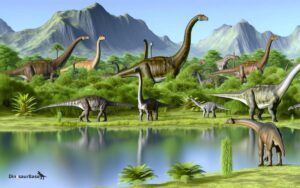What Dinosaur Has Spikes on Its Back
Isn't it fascinating how the Stegosaurus, with its distinctive spikes, has captured our imaginations?
This dinosaur, characterized by the row of large, bony plates and spikes along its back, has long been a subject of intrigue among paleontologists and dinosaur enthusiasts alike.
The purpose behind these spikes, ranging from defense mechanisms to thermoregulation, offers a glimpse into the complex lives of these ancient creatures.
While one might assume these features solely served as protection against predators, the Stegosaurus' spikes might have had other functions that are less obvious.
To uncover the mysteries surrounding this iconic dinosaur, one must explore the latest research and theories that shed light on its ancient behaviors and lifestyle.
Key Takeaways
- Stegosaurus is known for its distinctive dorsal plates and tail spikes, serving as defense mechanisms.
- The spikes, known as thagomizers, were possibly used for defense or thermoregulation.
- These features highlight Stegosaurus's evolutionary significance, including predator deterrence and possible roles in sexual selection.
- Stegosaurus's dietary behavior and defense mechanisms underscore its adaptation to its ecological niche.
The Distinctive Stegosaurus
One can't discuss the pantheon of prehistoric giants without acknowledging the distinctive Stegosaurus, a dinosaur that captivates with its row of unique, imposing spikes and plates adorning its back. This Late Jurassic era behemoth, predominantly found in what's now North America, has been a subject of intrigue and study, revealing much about the Jurassic landscape.
Its distinct appearance, characterized by the dorsal plates and spikes, suggests a complex evolution, possibly related to defense mechanisms or thermoregulation. Scholars assert that the Stegosaurus's physical attributes, notably its tail spikes, known as thagomizers, played a crucial role in its survival strategy, offering protection against predators.
This analysis underscores the necessity of examining the Stegosaurus within the broader context of dinosaurian evolution, where function and form demonstrate a sophisticated interplay.
Anatomy of the Spikes
Delving into the anatomy of the spikes, researchers have found that these formidable structures exhibit a complex composition and intricate design, suggesting multifaceted functions beyond mere defense.
- Material Composition: Studies reveal the spikes consist of a dense core surrounded by layers of tougher, protective material, indicating a structure built to withstand significant force.
- Attachment to the Skeleton: The spikes are deeply embedded into the dinosaur's vertebrae, providing strong structural support that suggests they were capable of absorbing high levels of stress.
- Variability in Size and Shape: Examination of various specimens has shown a surprising diversity in the size and shape of the spikes, hinting at a possible differentiation in function or display behavior among individuals or species.
This analysis underscores the complexity of these prehistoric creatures and opens new avenues for understanding their lives.
Evolutionary Purpose
Exploring the evolutionary purpose of the spikes reveals a multifunctional role that extends beyond simple defense mechanisms, offering insights into the selective pressures these dinosaurs faced.
The presence of spikes likely served as a deterrent against predators, making these dinosaurs less appealing targets. Moreover, the spikes could have played a pivotal role in thermoregulation, aiding in heat dissipation or retention depending on environmental conditions.
Additionally, the variation in spike size and distribution among species suggests a role in sexual selection, where spikes may have been used to attract mates or assert dominance within social hierarchies.
This multifaceted utility underscores the complexity of evolutionary adaptations, highlighting how natural selection molds physical traits to confer multiple advantages in survival and reproduction.
Dietary Habits
While the evolutionary purpose of spikes offers insights into the survival strategies of these dinosaurs, their dietary habits reveal equally complex adaptations to their environment. Analysis of fossilized remains and comparative anatomy has led to significant insights into these dietary habits:
- Herbivorous Lifestyle: Many spiked dinosaurs, such as Stegosaurus, primarily consumed vegetation, adapting to feed on low-growing plants.
- Selective Feeding: Evidence suggests that some species had the ability to select specific types of plants, indicating a level of dietary preference that contributed to their ecological niche.
- Gut Microbiota: The complex gut microbiota inferred from coprolites (fossilized feces) indicates that these dinosaurs could digest cellulose, allowing them to extract nutrients from tough plant materials.
These dietary habits underscore the diverse ecological roles spiked dinosaurs played within their ecosystems, reflecting a high degree of specialization.
Defense Mechanisms
The defensive mechanisms of spiked dinosaurs, evolving as a response to predation pressures, highlight their complex interaction with the Mesozoic ecosystems. These dinosaurs, such as the Stegosaurus, possessed rows of large, bony plates and spikes, serving not only as a physical barrier against predators but also as a display mechanism to deter potential threats.
Scholars suggest that these features could inflict serious wounds on attackers, making predation costly. Furthermore, the strategic placement of spikes along their tails and bodies provided an effective means for these creatures to defend themselves without needing to engage directly.
This evolutionary adaptation underscores the dynamic relationship between prey and predator, illustrating a sophisticated level of survival strategy that contributed to the longevity of these species within their habitats.
Stegosaurus in Pop Culture
Reflecting on the Stegosaurus's defensive mechanisms offers insight into its iconic status in popular culture, where its distinctive silhouette has captivated audiences in literature, cinema, and media. The Stegosaurus, with its spiked tail and plated back, has transcended scientific interest to become a symbol of prehistoric life's mystery and grandeur. This transition from paleontological curiosity to pop culture staple reveals the broader societal fascination with dinosaurs, serving as a bridge between academic research and public imagination.
- Literary Appearances: The Stegosaurus has been featured in numerous novels and children's books, often depicted as a gentle giant or a formidable foe.
- Cinematic Portrayals: Films have dramatically showcased the Stegosaurus, highlighting its defensive capabilities and contributing to its mythos.
- Media Representations: Beyond books and movies, the Stegosaurus appears in video games, cartoons, and logos, embodying prehistoric power and intrigue.
Discovering Stegosaurus Fossils
Unearthing Stegosaurus fossils, scientists have meticulously pieced together the evolutionary narrative of this iconic dinosaur, shedding light on its habitat, behavior, and physiological adaptations. The discovery of these fossils, primarily in the Morrison Formation of North America, has provided invaluable insights.
Through radiometric dating, researchers have pinpointed the Stegosaurus's existence to the Late Jurassic period, approximately 155 to 150 million years ago. The careful examination of bone structures and arrangements has led to a deeper understanding of its defensive mechanisms, particularly the distinctive spikes and plates.
Moreover, the analysis of fossilized pollen and flora alongside Stegosaurus remains has offered clues about its dietary habits and the ecosystem it inhabited. These findings underscore the Stegosaurus's role in its prehistoric environment and contribute significantly to our comprehension of dinosaurian ecology and evolution.
Conclusion
In conclusion, the Stegosaurus, a prehistoric icon, wielded its spiky armor not just as a defense mechanism but as a testament to evolutionary ingenuity. These spikes, akin to nature's own barbed wire, served multiple purposes, from warding off predators to possibly regulating body temperature.
Their diet, primarily lush prehistoric flora, underscores their role in the ancient ecosystem. Fossil discoveries have pieced together this fascinating tale, embedding the Stegosaurus firmly in both scientific study and pop culture, illustrating nature's complex tapestry of life.



